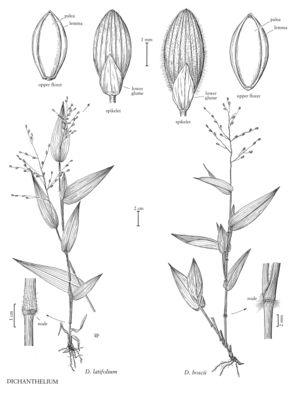Dichanthelium latifolium
Plants forming small clumps, with knotty rhizomes less than 2 mm thick. Basal rosettes well-differentiated; sheaths pubescent; blades ovate to lanceolate, dark green. Culms 45-110 cm, nearly erect; nodes glabrous or the lower nodes slightly bearded; internodes glabrous or sparsely pubescent; fall phase branching from the midculm nodes, branches nearly erect, scarcely rebranching, blades and secondary panicles only slightly reduced. Cauline leaves 4-6, often with a transitional leaf above the basal rosette; sheaths not overlapping, glabrous or softly villous basally, margins ciliate, collars pubescent; ligules 0.4-0.7 mm, membranous, ciliate, cilia longer than the membranous portion; blades 3.7-7 times longer than wide, 15-40 mm wide, ovatelanceolate, glabrous or sparsely pubescent, with 11-13 major veins and 40-120 minor veins, bases cordate-clasping, with papillose-based cilia. Primary panicles 7-15 cm long, 4-12 cm wide, 1.5-2 times as long as wide, with 20-80 spikelets, eventually at least partially exserted; branches stiff, ascending to spreading. Spikelets 2.9-3.9 mm long, 1.6-2 mm wide, ellipsoid, sparsely pubescent. Lower glumes 1/3 – 1/2 as long as the spikelets, narrowly triangular; upper glumes and lower lemmas slightly shorter than the spikelets, often red-tinged basally and apically; lower florets staminate, anthers exserted prior to those of the upper florets; upper florets pointed, apiculate, upper lemmas with a minute fringe of hairs. 2n = 18, 36.
Distribution
Conn., N.J., N.Y., W.Va., Del., D.C., Wis., Ont., Que., Mass., Maine, N.H., R.I., Vt., Tex., N.C., Tenn., Pa., Va., Md., Ala., Ark., Ill., Ga., Ind., Iowa, Kans., Nebr., Okla., Ohio, Mo., Minn., Mich., Miss., S.C., Ky.
Discussion
Dichanthelium latifolium grows in rich deciduous woods, often in slightly open areas within eastern North America. The primary panicles are open-pollinated and develop in May and June (and sometimes in September and October), the secondary panicles, which are produced from July through September, are rarely open-pollinated.
Selected References
None.
Lower Taxa
"usually distinctly longer and narrower" is not a number."decumbent" is not a number.
